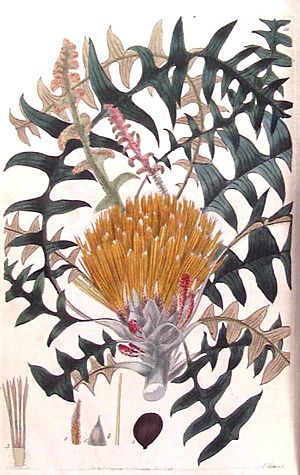Banksia alliacea facts for kids
Quick facts for kids Banksia alliacea |
|
|---|---|
 |
|
| B. alliacea from Robert Sweet's 1828 Flora Australasica | |
| Scientific classification | |
| Genus: |
Banksia
|
| Species: |
alliacea
|
| Synonyms | |
|
|
Banksia alliacea is a type of shrub found only in the southwestern part of Western Australia. It can grow up to 2 meters (about 6.5 feet) tall and wide. Its unique flowers look like shaving brushes and surprisingly, they smell like onions!
What it Looks Like
Banksia alliacea is a shrub that usually grows between 0.4 and 2 meters (1.3 to 6.5 feet) tall. It can spread out to 2 meters wide. Its leaves are arranged one after another along the stems. They are quite long, about 31 to 61 centimeters (12 to 24 inches) in length, and 6 to 13 centimeters (2.4 to 5.1 inches) wide.
Each leaf has 12 to 23 deep, pointed, narrow, triangular sections along its edges. The spaces between these sections are very deep, almost reaching the middle vein of the leaf. When the leaves are young, they are covered with fine, reddish-brown fur. This fur disappears as the leaves get older, leaving a smooth surface. You can see three clear veins on the underside of each leaf.
This plant flowers at different times of the year, usually from September to December, or sometimes from January to February, or even in May. The flowers grow in special clusters called inflorescences at the ends of the stems. These flower clusters are shaped like shaving brushes and give off a distinct onion-like smell. Each cluster has between 70 and 95 small, individual flowers.
How it Got its Name
This plant has had a few different names over the years! In 1827, a botanist named Robert Brown first described it. He called it Dryandra nervosa. He studied a plant grown from a seed by a nursery owner named John Bain Mackay in England. The seed probably came from near King George Sound in Australia.
For many years, people thought this plant was called Dryandra pteridifolia. But in 1996, another botanist, Alex George, realized that D. pteridifolia was actually a different species. So, he brought back the original name, Dryandra nervosa.
Then, in 2007, a big change happened. All the plants in the Dryandra group were moved into the Banksia group by botanists Austin Mast and Kevin Thiele. However, the name "Banksia nervosa" was already being used for a different plant. Because of this, Mast and Thiele had to pick a brand new name. They chose "alliacea." This name comes from the Latin word alliaceus, which means "onion-like." They picked this name because of the onion smell of the flowers!
Scientists have also done genetic tests. These tests show that Banksia alliacea is very closely related to another plant called Banksia pellaeifolia.
Where it Grows
Banksia alliacea is found in the Stirling Range area of Western Australia. Its range extends east towards Ongerup and Boxwood Hill, and south to Manypeaks. You can also find some groups of these plants further away, near the Lort River and in Cape Arid.
It usually grows in flat areas where the soil is a mix of clay and loam, or sand and loam. These areas typically receive between 400 and 800 millimeters (about 16 to 31 inches) of rain each year.
Growing it in Gardens
Banksia alliacea could be a good plant to grow in gardens, especially if you like plants with interesting leaves. It tends to grow better in soils that have some clay in them, rather than just pure sand.
See also
 In Spanish: Dryandra nervosa para niños
In Spanish: Dryandra nervosa para niños

